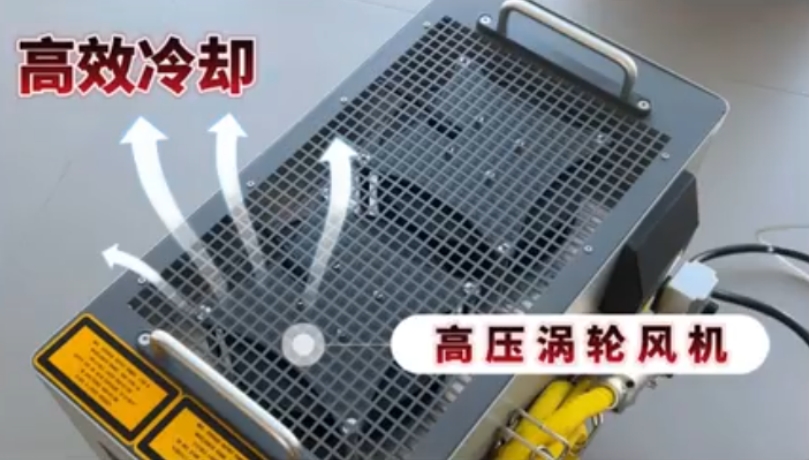Apr 29 , 2025
Generally speaking, water-cooled and air-cooled laser welding machines have their own advantages and disadvantages in laser welding applications. As we all know, water-cooled welding machines have emerged with the popularity of continuous fiber lasers, while air-cooled laser welding machines are undoubtedly a rising star in the past three years. This article will explore the following points. As a pioneer in the laser industry, we are committed to offering the most suitable welding solution.
The main sources of heat in fiber lasers are the pump source and the gain cavity. For the pump source, its conversion efficiency is about 50%, which means that part of the energy equivalent to the output optical power is converted into heat. If the heat is not dissipated in time, the temperature inside the chip will rise rapidly, causing the central wavelength of the laser to drift with the increase in temperature. In the gain cavity, after the pump light enters the active gain fiber, only a part of it is converted into laser output, and the rest of the energy is converted into heat. This heat increases the temperature of the gain medium, causing the fluorescence spectrum to broaden and the spontaneous radiation lifetime to shorten, thereby reducing the energy conversion efficiency. Therefore, thermal management is crucial for fiber lasers.Currently common thermal management technologies include air cooling and water cooling. Air cooling is mainly used for low-power pulse lasers and low-power continuous lasers, while medium and high-power fiber lasers mainly use water cooling as the main cooling measure.
The main difference is the thermal management technology. Water cooling as its name, it uses water to remove heat through a heat exchanger (such as a water-cooled plate). Its working principle is simple: cold water from the chiller flows into the heat exchanger through a pipe, then flows out from another port and returns to the chiller through a pipe, and this cycle continues to remove the heat from the laser.
Meantime air cooling refers to the use of fans and refrigerants to enhance air convection and achieve heat exchange inside the machine. No additional water cooling equipment is required, which reduces costs and significantly reduces the size and weight of the equipment.
When we talked about the air cooling laser welding sources. There is still have the difference between different technology. Although they are all called air-cooled lasers, the air-cooling schemes used are different: fan cooling, heat pipe cooling, compressor cooling
Fan cooling uses a substrate with good thermal conductivity (such as copper or aluminum etc.) to transfer the heat generated in the pump source and gain cavity to the heat sink, and then dissipate the heat by convection. Convective heat transfer can be divided into natural convection and forced convection according to the driving force of fluid flow. In the absence of external force, the fluid flows spontaneously due to temperature difference, which is called natural convection. Under the drive of external forces such as fans, the fluid flows rapidly and takes away the heat, which is called forced convection.

Heat pipe heat dissipation relies on the phase change of the working liquid inside the heat pipe to transfer heat. This liquid has a low boiling point and is easy to evaporate. One end of the heat pipe (evaporation end) is connected to the laser's radiator, and the other end (condensation end) is connected to the external radiator and fan. The tube wall contains a wick made of porous material. When the laser generates heat, the evaporation end heats up, causing the working liquid to evaporate rapidly. The steam flows to the condensation end under the action of the pressure difference, releases heat through the fan, and condenses into liquid again. The liquid returns to the evaporation end through the wick (in a gravity heat pipe, the liquid adheres to the tube wall and flows back under the action of gravity). This cycle continues to transfer the heat inside the laser to the outside.
The principle of compressor refrigeration is to compress the refrigerant into a high-temperature, high-pressure gas, which then flows to the external condenser. The gas condenses into a low-temperature, high-pressure liquid, and the heat generated is discharged to the outside through a fan. The low-temperature, high-pressure liquid refrigerant is decompressed by the expansion valve and becomes a low-temperature, low-pressure steam, which flows to the internal evaporator. The evaporator absorbs heat, lowers the temperature inside the laser, and the refrigerant evaporates into a high-temperature, low-pressure gas. The gas is then compressed again, and the cycle is repeated for continuous refrigeration.
Air-cooled systems are more suitable for low-power pulse lasers and some low-power continuous lasers especially for the power below 2kw with significant advantages with small size and lower cost for maintenance and also the shipping.
The cooling effect of air-cooled handheld laser welding machines is relatively weaker compared to water-cooled ones. Water-cooled systems use water flow to cool the laser beam, improving welding speed and efficiency. This cooling method is more stable and results in better welding quality compared to air-cooled systems. However, due to the need for water flow in the cooling system, water-cooled machines are relatively heavier and require more energy and also the higher cost in maintenance.
This is the first one.